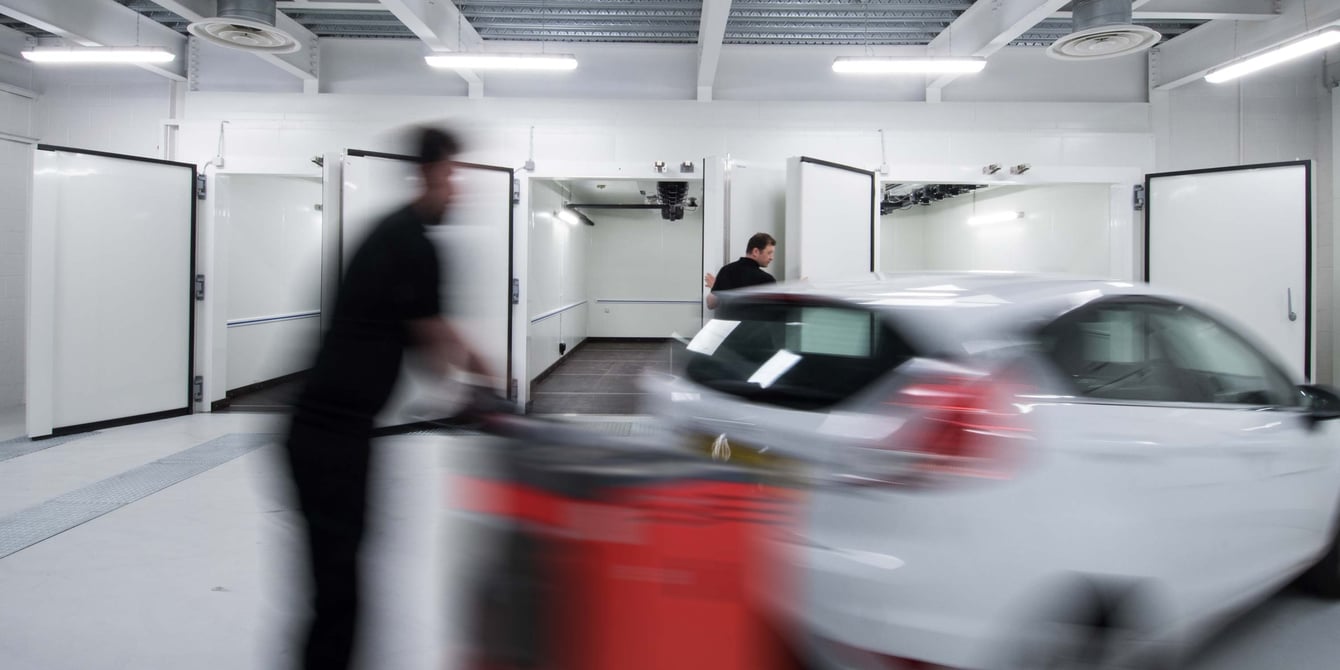When moving vehicles, a commonly used method is to rely on manual pushing by several people as well as being able to reach the car from all sides.
But in confined spaces, that’s simply not possible. Let’s look at some examples where the right tool enables safe and efficient vehicle moving where it would otherwise be nearly impossible.
4 examples of vehicle moving in limited spaces
Example 1
For an automotive manufacturer, each minute that the production line is stalled means money down the drain. Therefore, it’s mission-critical to get a non-starter out of the way quickly—without compromising staff safety. While most of the plant tends to offer plenty of maneuvering space, the end-of-line typically doesn’t. And as Steve puts it:
“As the space where you need to move your vehicle gets tighter, the safety margins start to narrow.”
With an electric vehicle mover, a single employee can remove a damaged car from the end-of-line in less than a minute – without unnecessary halts in production, or several other staff members having to drop what they’re doing to help.
“In these situations, the right machine will have paid for itself within a matter of minutes. When I’m out in manufacturing plants and show end-of-line operators how to use their vehicle movers, they always pick it up really quickly. A reaction I get a lot is ‘wow, this is like a tow truck for one,’” Steve says.
Example 2
When it comes to storing cars, every square meter counts. If you need to be able to fit a person (or just an open car door) between the stored cars to get one out, that’s a lot of valuable space wasted.
“I’ve worked with companies that could fit 22 cars instead of 20 in their facilities after investing in an electric vehicle mover. Of course, that has an immediate impact on their revenue,” Steve explains.
Example 3
Some of the tightest spaces you’ll find in vehicle moving are found on testing sites. To see the effect of extreme temperatures or wind forces, you need to place the car in a tiny cell that is just slightly wider than the car itself.
In these circumstances, time is critical. To test the effects of extreme temperatures or wind forces on the vehicle, the door of the testing cell or climate chamber can’t be open for longer than what is absolutely necessary. Otherwise, the conditions risk being affected by the surrounding air temperature, which compromises the parameters of the test.
“The longer those doors are open, the longer it takes to get the parameters back to where they need to be for the test to be valid. Instead of a time-consuming manual operation, an electric vehicle mover can get the car in and out quickly, with minimum impact on the testing conditions,” says Steve.
Example 4
Car museums that exhibit one-of-a-kind vehicles, priceless artifacts, and educational displays—often in a unique environment with limited maneuvering space—are ripe for a vehicle moving solution. As Steve puts it:
“Driving or manually pushing a car in that space is worrisome and worse, risks damage to the these precious vehicles.”
Time is also important since the museums tend to change their exhibitions on a regular basis; sometimes as often as bi-weekly. To minimize the impact on opening hours—and in turn, revenue—cars and artifacts need to be replaced and arranged as efficiently as possible, without putting staff or priceless exhibits at risk.
“An electric vehicle mover offers an efficiency and accuracy that is absolutely invaluable to museums.”
Tricky environments require customized vehicle movers
At Stringo, each vehicle mover is made to order, as Steve explains:
“What we do really well at Stringo, and that I’m personally very proud of, is that we tailor each vehicle mover to the facilities where the client will use it. Figuring out the best fit for each client, and then seeing the results it brings, is the most fun part of my job.”
Some situations require more customization than others:
“I’ve worked with a client where the space in the facility was extremely limited. We needed to scale down the length of the vehicle mover as much as possible to minimize the additional space that it adds to the end of the vehicle. Of course, all our machines are made to order, but in that particular case, we delivered a machine that’s really one of a kind.”





